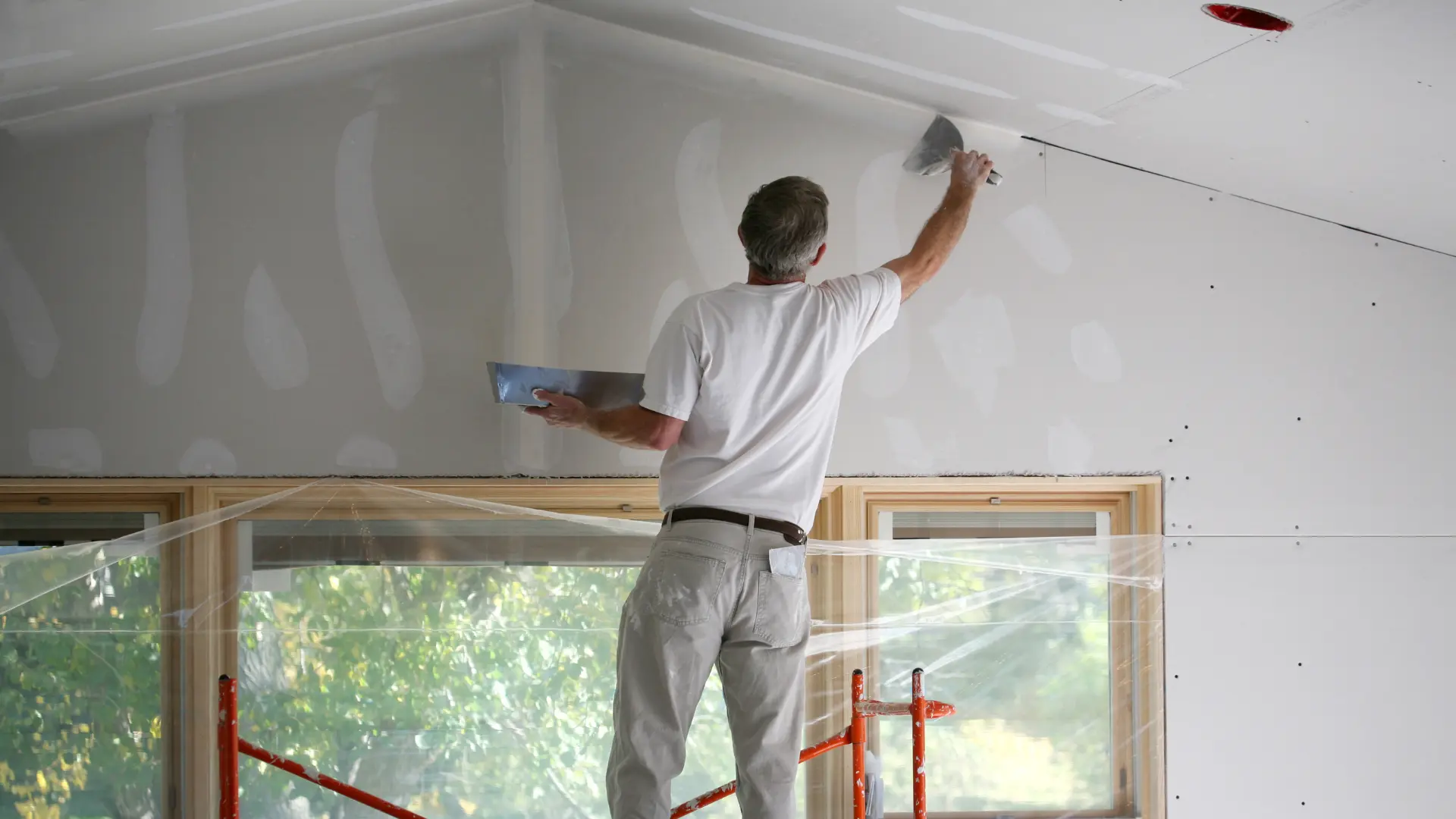Step-by-Step Approaches to Getting Flawless Drywall Repair Service and Installment
Attaining perfect drywall repair service and installment needs a systematic approach. It includes comprehending the various sorts of drywall and the devices needed for the job. Correct area prep work is vital prior to starting any type of work. drywall contractors. Each action, from covering openings to mounting new sheets, needs focus to information. The procedure does not end with setup; finishing techniques are essential for a polished appearance. The following actions will ensure a seamless result, but just what do they require?
Recognizing Drywall Kind and Devices Needed

The installation tools are similarly crucial. An energy blade is vital for reducing drywall sheets, while a drywall saw can help in making accurate cuts for fixtures or electrical outlets. T-squares guarantee accurate measurements, and drywall screws or nails secure the panels to wall surface studs. Additionally, a drywall lift can facilitate the setup of large sheets, lessening physical stress. Experience with these devices and kinds appreciably adds to the efficiency and quality of drywall projects.
Preparing the Location for Repair or Installation
Preparing the location for drywall repair work or installment is important to ensure a smooth and reliable process. The surrounding room needs to be removed of furniture and various other barriers to offer ample working room. This not just ensures safety yet likewise avoids damages to personal belongings. Next, it is necessary to cover the flooring with ground cloth to capture any type of particles or dirt generated throughout the work.
In addition, the walls need to be checked for any type of loosened paint or wallpaper that may hinder bond. Removing these aspects creates a tidy surface area for the brand-new drywall. Before beginning, it is suggested to shut off power to electric outlets or fixtures in the location. Making sure adequate illumination in the workspace will better boost exposure and emphasis during the repair service or installation process. drywall contractors. By carefully preparing the location, one lays the groundwork for an effective drywall project
Step-by-Step Process for Patching Holes
:max_bytes(150000):strip_icc()/SPR-solutions-to-common-drywall-problems-p2-4120949-not-on-stud_53719-051c5226ba8f478086c3994975acf8c9.jpg)
Patching holes in drywall requires a systematic approach to assure a smooth repair. The very first step includes examining the dimension of the opening. For tiny openings, a patching substance might be adequate, while bigger openings demand a spot. Next, the damaged location needs to be cleaned and prepared by eliminating any kind of loosened debris.
For small holes, applying spackling substance with a putty blade is suggested, smoothing it over the opening and feathering the edges. As soon as dry, fining sand the location guarantees a smooth finish. For larger holes, a drywall patch need to be cut to dimension, positioned over the opening, and secured with screws. After mounting the patch, the very same spackling procedure is repeated, followed by sanding.
Lastly, the patched location must be topped and painted to match the bordering wall. This careful process guarantees an expert appearance and extends the life expectancy of the repair work.
Mounting New Drywall Sheets: A Comprehensive Overview
Setting up new drywall sheets requires careful planning and implementation to ensure a visually attractive and tough finish. The location should be determined properly to identify the number of sheets needed. It is important to choose the ideal density, generally 1/2-inch for interior wall surfaces and 5/8-inch for ceilings or fire-rated applications.
Next, the studs or framework ought to be evaluated for any kind of irregularities, making sure they are aligned and properly spaced. When putting the drywall sheets, they must be positioned flat to decrease joints and improve structural integrity. A drywall lift can be helpful for above installations.
Attaching the sheets with drywall screws at appropriate intervals makes particular a safe setup. It is very important to countersink the screws slightly below the surface to plan for the ending up process. Following these standards will certainly result in a solid foundation, prepared for the following steps in drywall finishing.
Completing Touches: Taping, Mudding, and Fining Sand Techniques
As soon as the drywall sheets are firmly attached, the emphasis changes to the finishing touches that will offer a polished look. This process starts with taping, using either paper or fiberglass fit together tape to cover the seams in between sheets. The tape check here guarantees a smooth shift, minimizing the risk of splitting. Following taping, mudding is important; a joint substance is used over the tape to fill up gaps and create a seamless surface area. Generally, numerous coats are necessary, each one feathery out better than the previous to decrease presence.
After adequate drying time, fining sand is the last action in accomplishing a flawless surface. A fine-grit sandpaper is utilized to smooth the dried substance, ensuring there are no blemishes or bumps. Focus to information during this phase is considerable, as it significantly influences the total appearance of the wall surface. Completion result need to be an even, professional-looking surface ready for priming and paint.
Often Asked Questions
Exactly how Do I Pick the Right Drywall Thickness for My Task?
To select the appropriate drywall density, consider the task's purpose, place, and structural requirements. Criterion thicknesses consist of 1/2-inch for general use and 5/8-inch for fire-rated applications, making certain durability and compliance with building ordinance.

Can I Mount Drywall Over Existing Drywall?
Yes, mounting drywall over existing drywall is possible. Nevertheless, it is important to ensure the underlying surface is complimentary and secure from damage. Appropriate fastening and consideration of density are important for a successful installation.
What Are the Ideal Practices for Drywall Disposal?
The best practices for drywall disposal consist of recycling when feasible, utilizing regional waste monitoring services, and following standards for harmful products if suitable. drywall contractor. Effectively sealing and labeling waste warranties compliance and security during disposal
For how long Should I Wait On Mud to Dry Prior To Fining sand?
Commonly, one need to wait 24-hour for drywall mud to completely dry prior to fining sand. Drying time can differ based on humidity and temperature level, so examining for a company structure is advisable before continuing.
Exist Eco-Friendly Drywall Options Available?
Yes, environmentally friendly drywall alternatives are readily available. These choices commonly utilize recycled materials, low-VOC adhesives, and lasting manufacturing approaches, lowering ecological impact while offering efficient insulation and durability for various building and renovation projects.
An utility blade is crucial for reducing drywall sheets, while a drywall saw can aid in making precise cuts for components or outlets. Preparing the location for drywall fixing or installation is vital to guarantee a effective and smooth procedure. Covering holes in drywall needs a methodical method to ensure a smooth fixing. Installing brand-new drywall sheets calls for cautious preparation and execution to guarantee a visually enticing and durable coating. Yes, installing drywall over existing drywall is possible.